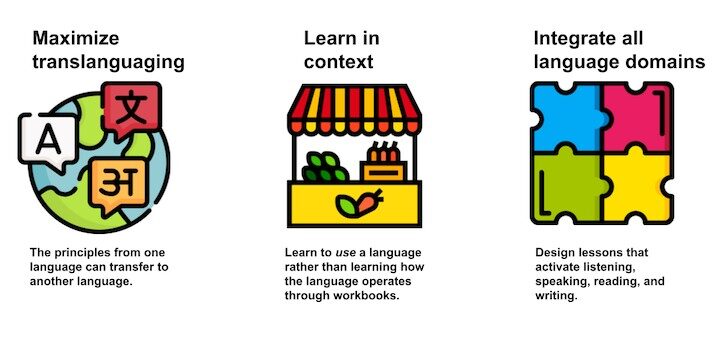Category: The Unstoppable ML Teacher
Content-based exams should gauge understanding of discipline-specific skills and concepts. But for many multilingual students exams are a reading and writing test in disguise. Language specialists Tan Huynh and Beth Skelton show how we can engineer justice into the assessment of MLs.
As he develops new co-teaching relationships, language specialist Tan Huynh focuses on two essential strategies: establishing schedules and making “relationship deposits” that build the teacher to teacher connections needed to assure the classroom works for all students.
This lesson planning template created by Tan Huynh and Beth Skelton serves the learning needs of both multilinguals and non-MLs in any subject. It helps assure planning is highly structured and intentional, lessons are accessible, and success is within reach of all students.
As language specialist Tan Huynh learns Khmer, his 6th language, he looks into language acquisition as a skill, not a superpower. He suggests teachers support students’ multilingualism by maximizing translanguaging, learning in context, and integrating all language domains.
When students can clearly see the path before them and how to get there, they can achieve the highest expectations, says language specialist Tan Huynh. His S.P.E.N.D learning tool (statistics, places, events, names, dates) brings clarity to research and writing.
A culturally sustaining and relevant pedagogy for multilingual students assures grade-level academic progress, strengthens first-language usage and sustains cultural connections. Dual language programs are the best path forward, writes language specialist Tan Huynh.
Teaching academic content is less about receiving students who are ready to learn and more about creating conditions to support learning. Tan Huynh shares a geography lesson he designed to meet three conditions multilinguals need to learn content and language simultaneously.
Language specialist Tan Huynh offers a framework called the 3 C’s of Equity – Community, Curriculum and Culture – to guide schools on the journey to provide an equitable learning experience for their multilingual learners. To start, avoid deficit-based models that segregate.
Tan Huynh’s message to co-teaching language specialists who struggle to be recognized as equal partners: “Power is not only given but reinforced one interaction at a time. The chains that limit marginalized students are the same chains that hold down marginalized faculty members.”
A strengths-based approach to teaching multilinguals means understanding what students bring to schools. We can use dialogue journals to invite students to have a conversation with us about their strengths. Tan Huynh shares how he implements the weekly exchange of notes.
























